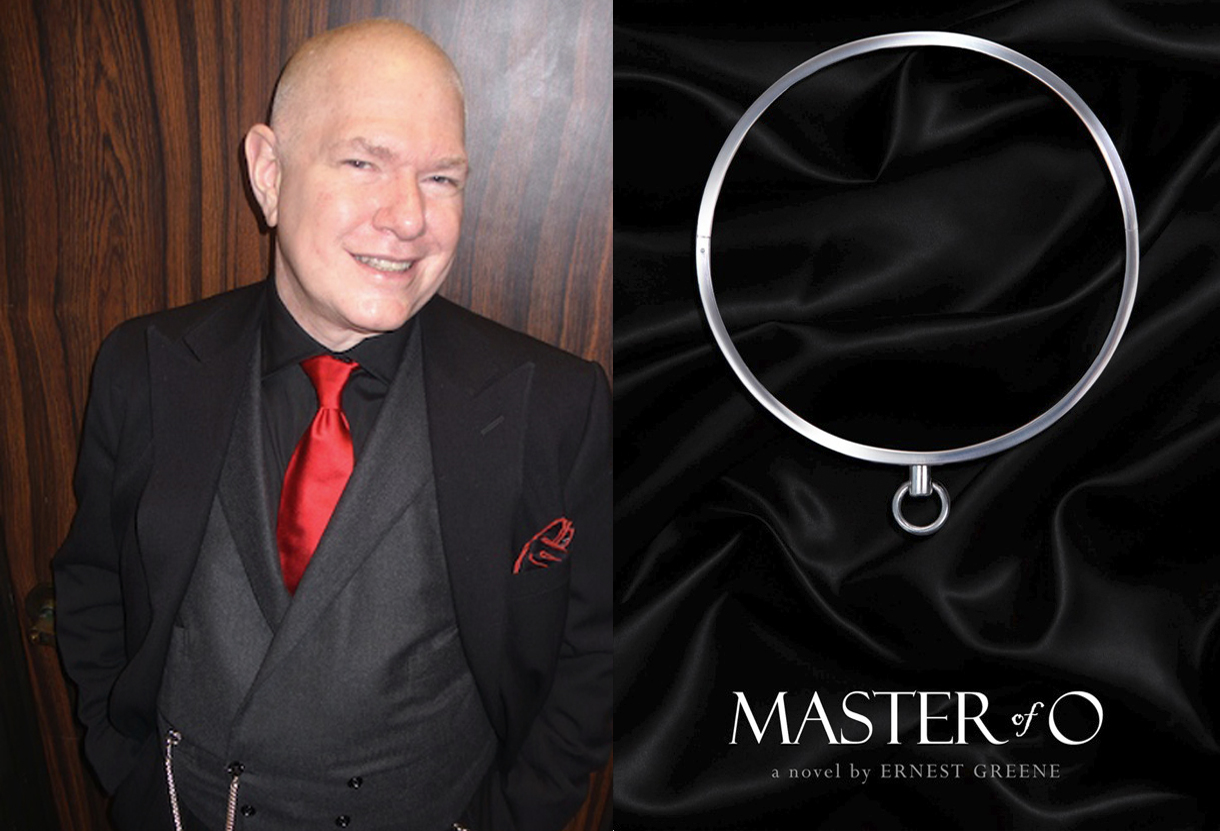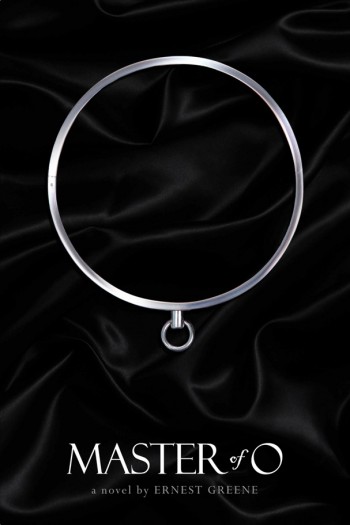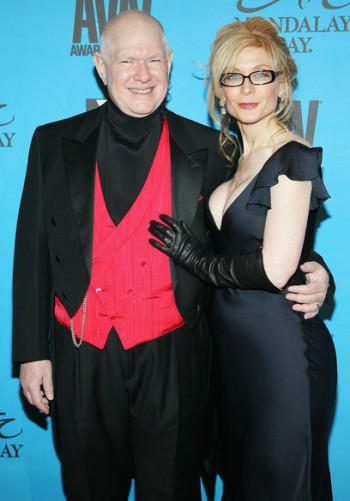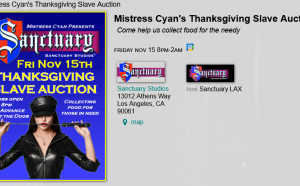TRPWL readers may be most familiar with Ernest Greene as the award-winning fetish and erotic filmmaker whose directing, producing and performing credits over the last 30 years number in the hundreds — or perhaps as the longtime editor of Hustler’s Taboo Magazine. Greene is also board chairman emeritus of the Adult Industry Medical Health Care Foundation a.k.a. AIM (seven terms beginning with its creation) and a staunch defender of the medical clinic for and by adult performers that was destroyed by AIDS Healthcare Foundation during its crusade against the adult business.
But what many may not know is that Greene, nee Ira Levine, has worked in virtually every type of mass media, beginning with a publication in Esquire in 1969 when he was still in his teens. He later worked as a reporter for The Rocky Mountain News, held gigs in television and talk radio, made the rounds as an independent journalist, and toiled as an under-appreciated independent screenwriter. His writing has also been published in Rolling Stone, Details and Harpers.
He’s one of the sharpest and most eloquent people one could hope to encounter, and, as those who’ve read his comments on this site can attest, Greene’s keen powers of observation and political savvy are matched by his directness. He’s not known to mince words.
 Greene’s fascination with the 1954 erotic novel Histoire d’O (Story of O) dates back to his adolescence. The book was written by Anne Desclos under the nom de plume Pauline Réage, and centers around a Parisian fashion photographer (O) who gives herself completely first to her lover René, and then to his older, more dominant brother, Sir Stephen.
Greene’s fascination with the 1954 erotic novel Histoire d’O (Story of O) dates back to his adolescence. The book was written by Anne Desclos under the nom de plume Pauline Réage, and centers around a Parisian fashion photographer (O) who gives herself completely first to her lover René, and then to his older, more dominant brother, Sir Stephen.
“To say that the book was a revelation is to understate its impact,” Greene writes of his first encounter with Desclos’ classic. “For the first time I saw on paper vivid descriptions of my own fever dreams of conquest and surrender.” Still, as many readers have noted over the years, there’s something unsatisfying about the book, particularly in the third act.
In the forward to Greene’s new novel, Master of O, he acknowledges that he was left “exasperated by the lack of any resolution that made sense in light of what had come before.”
“Some part of me, the born script mechanic, just wanted to get in there and fix what was wrong with it,” Greene told me. He eventually made three erotic movies about the enigmatic O: O, The Power of Submission (2006), The Surrender of O (2008) and The Truth About O (2012).
“Surrender of O turned out to be the biggest seller of the three because it had Bree Olson in it, so it had a little help from Charlie Sheen,” Greene quips.
Master of O, however, is no mere retread. His novel is a re-imagining of Desclos’ characters as seen from a dominant man’s point of view, rather than the submissive O’s.
I should also note that, aside from Greene’s other achievements during his decades in the adult business, he’s also married to the great Nina Hartley, making him, statistically speaking, the luckiest man on the planet since Rick Ocasek landed Paulina Porizkova.
I’ll take musician analogy one step further, and deeper: in Master of O, Greene riffs on a classic piece of literature with all the virtuosic skill of a seasoned jazz man tackling a pop standard. Greene has infused it with something new and deeply personal. The joyous result is a re-envisioning of a another landmark work: the transcendent, erotic literature equivalent of John Coltrane recording “My Favorite Things”. It’s hot, yes, and in a way only scenarios involving realistically-drawn characters can be — but it’s also fun. And like the finest art, it rings completely true and resonates long after its final page has been turned.
That the book has earned raves comes as no surprise to us. On behalf of TRPWL, I give Master of O our highest rating — three thumbs up!
Master of O, published by Daedalus Press, is available via http://masterofo.com/ and on Amazon.com. Follow @TheMasterofO on Twitter
Ernest Greene and Nina Hartley will read from Master of O at Stockroom in Los Angeles on September 12, 2014.
I hope you enjoy my conversation with Ernest Greene about his magnum opus…
Like you, I read the original O when I was a teen with limited sexual experience. I thought it was a great “sex book”, although, to me, it seemed a bit antiquated in its presentation. When I revisited the book after I moved to Los Angeles, it somehow felt more relatable. That’s something you’ve alluded to that in the promo materials for your book.
Well, there are some interesting similarities between Paris in 1953 and Los Angeles today, and some parts of it actually hold up very very well in terms of context, particularly those parts that deal with with O’s peripheral observations of the people around her. The author, we now know, traveled among very diverse people, and some of them are people we recognize as modern types — which is one of the reasons that I wrote the book. I could see those similarities. But where it falls apart is the middle, in the center of the story, with those three characters, because we now know some things about BDSM as a source of mutually pleasurable sex play for consenting adults that at the time of the writer, “Pauline Réage”, it wasn’t in view, in the light, in that culture. In short, we’ve come out of the closet. If you read the writing of gay writers in that period its similarly somewhat murky because they didn’t feel as free to write about their lives as they would in a few years.
Those gay writers were being murky about what was their own sexuality; Desclos was, it seems, an observer who was writing about others.
Yes, and you have to remember, the author had very conflicted feelings, to put it charitably, about people who engaged in this kind of behavior, and about the behavior itself, because she was in love with a man who was very much a part of that world, and she had no interest in it herself. She didn’t find it appealing or attractive, but on a dare she said “I can’t do the things you like to do, but I can write about them. I can write the kind of book you want to read.” So she wrote the thing as a birthday present to him and read it out loud with the idea that it would never be published, and of course her boyfriend at that time, Jean Paulhan, was already a big literary figure in France and said, “Oh no you’re not going to throw that out!” and he took it to his friend the rather daring publisher Jean-Jacque Pauvert, the first modern publisher to publish Sade in France. So he was a publisher of a type that we know pretty well these days; he would be succeeded over here by Barney Rosset [the legendary owner of Grove Press], who did the same thing.
So, they fought the battle to get Story of O published in France, which took some doing, but they did get it published and it caused quite a sensation. In a way, for the writer it became the kind of plague that Sherlock Holmes became for Arthur Conan Doyle: she never liked this character, she didn’t like these people. She was actually a well-regarded scholar of English lit and a person of substance in her own right and the last thing she wanted to be remembered for was a pornographic trifle that she wrote for her boyfriend and that turned out to be the thing that everyone remembered!
One thing we can say with certainly is that you’re immune to charges of being a carpetbagger who’s come to cash in of the mommy porn of 50 Shades of Grey.
She’s the carpetbagger, [laughs] I was here first. I’ve been active in the BDSM community for thirty years, and I’ve been editor of Hustler’s Taboo for fifteen. I’ve been making BDSM porn and erotic videos since 1989. So I really don’t think that anyone can accuse me of following [E.L.] James’ act. I think, if anything, it’s kind of the other way around. James admits, quite honestly, that she did her research on the internet and not through direct contact with any of these people. That’s not where I did my research! My research was done in the field. [laughs]
This is also subject matter that you’ve addressed in three of your movies.
Story of O always fascinated me for everything that was good about it and everything that wasn’t. Some part of me, the born script mechanic, just wanted to get in there and fix what was wrong with it. So, with the fairly modest means that were available, to do it on video, that’s where I started. That’s where I created the character of Stephen, the master of O who is the center of the novel.
I’ve always felt that one of the deficiencies with BDSM literature in general is that it’s so focused on the submissive experience — which is understandable because from a dramatic point of view, the person to whom things are happening is a very easy perspective to go for. But it also leaves us in the dark somewhat. What about these guys? Who are they? What do they do? What makes them that way? So from the beginning, with the movies, I wanted to take that kind of traditional gender bipolarity out of the thing, and the notion that men are all dominant and women are all submissive, and set it in a modern world where everybody had independent choice and they were doling what they wanted to do. They chose to be with their partner because they enjoyed what they were doing.
I had been making other kinds of BDSM-oriented erotic pictures for a long time, and they were all focused on pleasure, not pain. I hated the conventions of that genre when I got into it; at that time it was all about women who were mad at each other as if their shoes were too tight, and were miserable. All the doms were barking and nasty, saying, “I’m gonna punish you because you deserve it!” followed by women cringing and saying, “No, no don’t hurt me!” And then there’d be some kind of switch and they’d change roles, but there was never any eroticism to that. I wanted to show, in the movies, why — not how, but why — people would want to do this. And of course when you see beautiful people in beautiful surroundings doing it well, it’s not so hard to understand. The mission with the movies, in a sense, was to present BDSM as sex play between consenting adults with the eventual intention of terrific orgasms. In all three pictures, we carried through the arc of that. We had a dramatic backstory about these people and their complex relationships. But really what I was hoping to do was to put it in a modern context with the modern idea that sexual choice is a right, and that people should find out what they like and find other likeminded people, and do that thing without feeling shame.
It’s not a sugar-coated portrayal of it, I don’t think, but I attempted to portray this kind of sexuality…
As sexuality…
Yes, and in a positive light. I took, as the armature to build the movies around, the Story of O. But I gave the women much stronger identities, and I made the guys more eccentric and likable, and we got to know a little bit about how they lived. In the original book there’s nothing about how they lived. In the sequel to the book, which was written years later when the author was really sick of this, she took everyone backstage and showed what was really there, and that’s why a lot of people who love the first book hate the second one. Well, you could say I started with the second one.
I would call those pictures, in many ways, rehearsals for writing this book. I always wanted to be able to spread out the story the way you could not do even in a three-hour video, because you’ve got all that sex you’ve gotta shoot.
Like your movies, the book definitely illustrates the connection between BDSM and sex.
Somehow, some people just don’t get that. Here’s a question I get that drives me absolutely berserk: People will ask, “Ummm, do yo guys ever actually, like, fuck?” No, we just beat each other up, then go home and take a cold shower…. This is foreplay! This is how we get excited and then of course we fuck, are you crazy?
If you didn’t, you’d be extinct. You’d end up like the Shakers.
I think there is a genetic component of sadomasochism that’s present, to some extent, in everybody. In most people it’s fairly mild, and doesn’t really impact their lives very much, but with some people it’s as if, while on the assembly line somebody said, “Hey, give this one an extra shot of this stuff.” You come into this world already knowing you’re different. I assure you that by the time I knew anything about sex, I knew that this was the kind of sex that I was interested in.
Do you think that the misconception about whether people into BDSM ever fuck is in some way a result of the kind of BDSM product that was available for so long? These very arch melodramas which, also, did not show penetration. There would be some very severe punishment meted out over a missing lipstick!
“What did you do with my other shoe?” That was their idea of a script. There was an incredible disconnect between the BDSM community and how it was portrayed. It goes back to the days of Irving Klaw and Bettie Page, when they were trying to figure out ways of selling sexy stuff without getting in trouble with the law. It was fetishism that didn’t involve nudity or intercourse, and that convention remained.
By edict of genre.
Yes. BDSM pornography, until we were eventually able to show something more realistic, was 100% wrong. Anne Declos, as an author writing the Story of O, was about half wrong. I toiled over those horrible bondage videos for the first seven years of my career working as a bondage rigger and, man, I told myself then, if I ever get behind the wheel we’re going someplace different than this.
With the three O videos I did, in the way that only Nixon could go to China, I was able to get the most conservative company in the business, Adam & Eve, to back those features. Adam & Eve has an enlightened attitude toward sexually adventurous couples, and that’s how they saw it. They were totally supportive of it.
Desclos’ book was written from her own perspective, as someone who isn’t part of that world. However, it is your world. You write, in your foreword, that you’ve long felt “that there was another story that had been left untold…. I found it an infuriating tease, as if the writer knew a whole lot more but didn’t care to expose it or herself to the accusations that it would surely bring.” Do you feel that fixing the Story of O is your life’s work?
It was. When I first read it, which is when I was first having my own awakening about my identity as a kinky person, I found it in one sense terribly liberating because she had enormous powers of description — let’s not short this particular author’s real talents. She really did know how things looked and she knew how to render scenes in a very compelling and believable manner. So, when I first read the book I thought, ‘These are the kinds of things that really interest me, and they seem accurate.’ But when it got down to the characterization part of it, it completely fell apart because she didn’t understand, or like, these people. When I got to the end of the book — and it’s not a very long book; it’s only a couple hundred pages — I remember I threw it against the wall. I was so annoyed, because I just knew that the parts that were left out were the things that would’ve made it into a novel instead of what it had been intended to be: just an amusement.
There was stuff of substance in there, she was too good a writer not to include that, but she had too little comprehension and too much anxiety and contempt about this kind of life to really tell us anything about the inner lives that these people. Why in the world would an accomplished successful fashion photographer who had a long history as a ruthless heartbreaker or men and women throughout her whole life suddenly give up everything to become a slave of one guy who’s shallow and silly and doesn’t know anything, then to his step brother who turns out to be a piece of granite? What was it that made this thing happen? She sacrifices everything for something that a) gave her no pleasure, and b) for guys that clearly didn’t warrant it.
Now, being in the romantic tradition, which was an important part of what the author had studied as a scholar, the logical thing to do was to say it was all erotomania: it was all done out of an excess of love. She was so in love with this guy that anything he wanted from her was not too much, and it was about romantic sacrifice. You know, Anne Desclos was part of a group of mystical Catholic cults before the war. She had dabbled in that sort of thing and she was kind of a spiritualist sort of person, and I think she saw that as a motivation.
The character ends up a kind of romantic martyr in her story.
That’s exactly what she wanted O to be. She wanted to kill her. That was her intention — she even wrote a chapter in which it happened. Paulhan said, “No, that’s going to ruin the book.” In those days you could do that kind of thing, you could basically say to a writer “no we’re not publishing that part of it.” In any event, she saw O as this strange kind of saint, of a somewhat satanic nature, who had given herself over completely to this thing and, in the end, the only way to conclude it was with martyrdom. Well, that’s a very European idea, but it’s not true at all. And I don’t think the motivation was believable either, because, basically, nobody ever took a second whipping out of love. They deny furiously throughout the book, starting with the introduction, that any of this has anything to do with sadomasochism. If you believe that I’ve to a bridge I can sell ya.
For the reader who’s not a part of the kinkster community, what will he or she get from reading your story that they wouldn’t from Story of O?
What they’ll get is an understanding of what pleasure is to be had from doing this, and that it is principally a pleasure-driven activity. And that for those of whom it is not physically pleasurable and psychologically satisfying at a personal level, there’s no appeal to it at all.
You also write, in the book’s foreword, that you believe kink is “orientational in the way that being gay is orientational to those of us for whom the alternative would be celibacy rather than convention,” and that “kink, like gay, is at least partially heritable.”
One can easily overstrain this parallel, and be very offensive and stupid about it, and I don’t mean to do that, but there are many ways in which, depending on how much it defines your identity, BDSM is orientational. It’s the thing that turns you on. That doesn’t necessarily mean there’s nothing else that turns you on, but it is the main thing that does. It provides a physical and emotional kind of satisfaction, and I do believe there’s a genetic component to it, and that some people are tuned into that frequency. And they don’t have to explain why because they have nothing else in common within one another. If you hang out with a group of BDSM people — I always like to say, ‘If you’ve met one of us, you’ve met one of us.’ They often have nothing much else in common. Just as you wouldn’t expect that, because a group of people happen to be gay that they’re automatically going to be good friends.
Looking at it the other way round, Pythagoras famously dispensed with the idea that astrology had any validity by pointing out that even identical twins don’t have the same future.
Yes, it is a way of trying to pigeonhole people and things that are otherwise complex subjects that are hard to understand. If you’re not a person for whom power play sex resonates, then it just looks completely strange and rather frightening.
Now, if you’re a person with even a little bit of that wiring, it will at lest be intriguing. And what I tried to do is at present it at its best, to have experienced, knowledgeable players doing it, and showing how they do it. One of the things Master of O does that I don’t think has been done before, is it doesn’t “fade out” anywhere. It takes you right through the door, into the room where they do it, and lets you actually see what it is we talk about when we talk about BDSM — a subject much discussed and seldom understood.
We were talking about the romantic tradition and such, but I think readers will be pleased that you’ve made a more passionate story, a more explicably passionate one. And its also passionate in the telling.
Oh yes. For one thing, in some sense every author is telling his or her own story, whatever the subject matter is, and there is some of me in there even though it’s not an autobiographical character. I had two missions: I wanted to show something real about BDSM relationships — the physical aspects of them and the emotional aspects. The physical aspects of them are rather unique and exotic, but the emotional aspects of them are exactly those of any other kind of relationship. A BDSM relationship is still a relationship. People become involved with one another, they fall in love, sometimes that works out and sometimes it does not. And like any relationship, if the parties only connect at a sexual level, it will burn out.
The other thing I wanted to do: I felt that one of the good things that many people who’ve read Story of O have not recognized, is the subtle but constant presence of social observation in the book. Though that was not the author’s intention, she told you a lot about an certain circle of people in post-war Paris who have a pretty direct analogue here [in Los Angeles]. This too is a place of reinvention; a place where people of mysterious backgrounds and unknown means come to invent themselves as new people and build new lives. Also, Paris, after having been crushed as a center of high culture began to develop itself as a center of popular culture in a way that Los Angeles is. There’s a world of opportunities for those who can make those opportunities happen, if you’re a part of that striving class — and Story of O is very much set in that striving class. For a few of them it works very well, and for most of them it doesn’t work all that well. I also sensed a lot of noir-ish characters in the original book and I wanted to really emphasize that.
No better place than Los Angeles for that.
And L.A. is a character in this novel. The master of O is a highly paid criminal lawyer who very discreetly fixes problems for all kinds of rich and powerful people. Unlike a noir detective who’s out to solve mysteries, he’s a man who’s out to prevent mysteries from being solved. He’s a classic Los Angeles kind of fixer.
The author Mel Gordon wrote of your book: “Reading this erotic noir is like rediscovering Mickey Spillane and the entire oeuvre of Grove Press in one sitting.” It really is the sexual equivalent of a roman noir.
Obviously the original Story of O is an ancestor to this book, but there are some others, from James M. Cain, Joan Didion, Nathaniel West — people who wrote about Los Angeles the way it really is.
That world is a bit submerged today.
But it’s still here — the Los Angeles of Chinatown. And Stephen, the protagonist, is a local guy, which is unusual — not that many people are from here. He grew up here and he understands the system. He works it brilliantly. And that’s part of what makes him such an appealing character for O; she’s impressed with his virtuosity at what he does even if she doesn’t think it’s the most morally elevated thing one could do with one’s life.
The fact that they’re not perfect, black and white characters helps makes the relationship believable.
My main mission was to make a likable, believable, flawed but realistic, dominant male character, something which we have not seen anywhere. Nobody has really done that. That’s why it’s Master of O and not any other version of O. It’s his story and how he relates to her, and about how the world looks through his eyes. We’ve never looked through those eyes.
It’s easy to understand why someone would not want to be submissive. Anybody can understand that. It’s not so easy to understand why somebody would want to be submissive, and who they would want to be submissive to, and what about them would make them attractive. So, I really did my best to create a believable guy who believable women would find attractive.
Finally, your book is not meant to be viewed as ‘The Advanced Guide to BDSM’ in fiction form…
Absolutely not. First of all, BDSM relationships, like any other, are all different and depend upon what’s right for the individuals involved. Their interactions, their dynamic, their internal chemistry. What I never intended to do, and do not wish this to be read as — and feel that, to some extent, in the absence of any other literature, the original Story of O sort of became — is a work that is prescriptive in any way. There is no one true way to do this; there is no right way or wrong way so long as it’s consensual and safe.
I’m not putting this forward as a relationship template for people to follow. I really just want them to read a good story and enjoy it, and try to understand the se people and their lives to some extent. I’m not advising them to take it home, flip the book open next to the bed, and try and do everything that’s in it. It’s not about that. It’s not an instructional book. I’ve made plenty of instructional videos with Nina. We love ’em, we love doing them, some of them were even kink-oriented, but this book is a work of fiction and it’s meant for entertainment.









[…] He’s one of the sharpest and most eloquent people one could hope to encounter, and, as those who’ve read his comments on this site can attest, Greene’s keen powers of observation are matched by his directness. …read more […]
[…] In Conversation with Ernest Greene About His Novel, Master of O […]
One minor caveat to an outstanding interview: wasn’t AIM’s official name the Adult Industry Medical Foundation? I don’t think that “Healthcare” ever was part of their name…but I could be wrong.
A quick visit to the California Secretary of State’s website reveals the answer:
Entity Number: C2089709
Date Filed: 07/09/1998
Entity Name: THE ADULT INDUSTRY MEDICAL HEALTH CARE FOUNDATION
I lay, as it is, corrected. Thanks.
“…I should also note that, aside from Greene’s other achievements during his decades in the adult business, he’s also married to the great Nina Hartley, making him, statistically speaking, the luckiest man on the planet since Rick Ocasek landed Paulina Porizkova…” LOL.. my favorite part 🙂
[…] Sept. 18, fans of BDSM and of adult entertainment in general are invited to spend an evening with Ernest Greene, the author of the new book The Master of O, and his wife, actress/director Nina Hartley, as they […]
[…] Greene’s exclusive interview with TRPWL may be found here. […]
[…] and filmmaker Ernest Greene, author of Master of O, and erotic film legend Nina Hartley will be on hand at the Pleasure Chest […]
[…] classic Story of O by Pauline Réage aka Anne Desclos – and right behind it is Master of O by our friend, Ernest […]
[…] Many thanks to Peter Acworth, and our great friend Mr. Ernest Greene. […]
Met Nina Hartley – a friend used to have porn stars visit his video store in the 1980s Wow! Just wow! living, breathing !She asked me what to write on the vid box … I was speechless! She wrote something hard-on appropriate! Priapic I should say! Bondage vids came later